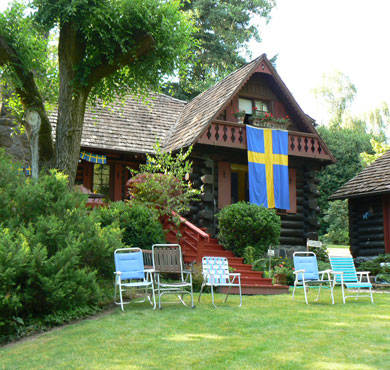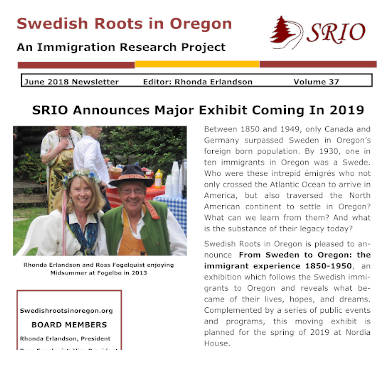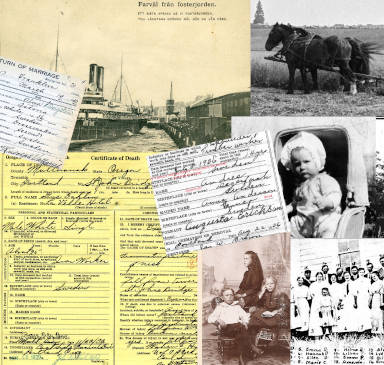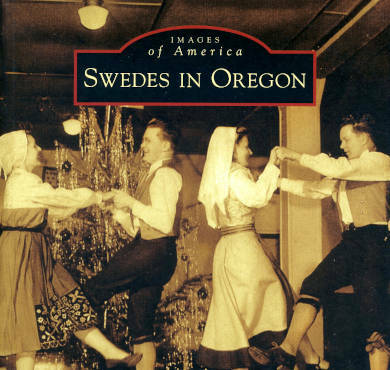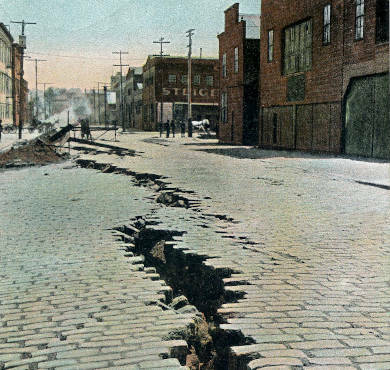Martin Peterson’s article “The Swedes of Yamhill” is a valuable contribution to the Swedish history of Oregon because it illustrates how a coherent Swedish farming community happened to come into being in the 1890s
Introduction to The Swedes of Yamhill
During the last decades of the 1800s—a period that coincided with the peak of Swedish immigration to the United States—several factors combined to stimulate a Swedish influx to the Pacific Northwest. First of all, Oregon’s State government had decided to encourage farmers from northern Europe to come to the region by having various promotional material translated into Swedish (among several other languages). In addition, there were the activities of Ernst Skarstedt, a somewhat romantic and inept pioneer, but highy capable journalist, newspaper editor and author who tirelessly promoted the Pacific Northwest in several Swedish-American newspapers and books. Two of his books deal with Oregon at great length: Oregon och Washington (1890) and Oregon och dess svenska befolkning (1911). So word quickly spread among the Swedes, who had one of the highest literacy rates in Europe at that time, that this corner of the United States had an almost Scandinavian-looking environment where one could practice the things one knew from home—farming, fishing and logging.
Around the turn of the 20th century a number of Swedish farming communities established themselves in many places in Oregon. Some Swedish wheat farmers settled east of the Cascades and formed the Valby congregation in Morrow County, but most found the land and climate west of the mountains more attractive. A large group came early to start farms in Powell Valley near Gresham, but the most ambitious settlement was probably the Carlsborg Swedish Colony established in Colton, Oregon, organized by Pastor C. J. Renhard (another tireless promoter who, among other things, also founded Emmanuel Hospital in Portland). C. J. Larson managed to attract a large number of Swedes and Swedish Finns to Warren, an area along the Columbia River between Scappoose and St. Helens. Valdemar Lidell, who was the Swedish vice-consul in Oregon around 1910, promoted a Swedish colony called “Newhem” near Sheridan (also in Yamhill County), and yet another group called the American-Scandinavian Realty Company advertised two Swedish colonies east of Oregon City called “Elida” and “Outlook.”
Not all the rural Swedish communities in Oregon were, of course, organized and actively promoted “colonies.” Many came into being spontaneously in areas where large numbers of Swedes had settled. These areas include farm country all along the lower Columbia River and the Pacific coast, especially around Tillamook and Marshfield (near Coos Bay). In addition, there were also large agricultural businesses operated by Swedes, the most famous of which was the Western Oregon Orchard Company in the Medford area, run by John and William Westerlund.
Today, a hundred years later, all of these Swedish rural communities are gone, even though descendants of the original settlers occasionally still live on the farms that their great grandparents started. Some of the old farmhouses and most of the churches built by the original Swedish settlers still stand, and visits to the adjoining cemeteries usually reveal many familiar-sounding names. And driving around in these areas we often recognize the names of many of the roads as well—whether it be Olson Road, Lindberg Road, or Carlson Road.
Martin Peterson’s article “The Swedes of Yamhill” is a valuable contribution to the Swedish history of Oregon because it illustrates how a coherent Swedish farming community happened to come into being in the 1890s, how it managed to remain an ethnic community, as well as giving us a glimpse of what farm life in Oregon was like more than a hundred years ago. It is also of great value to us because it is the only in-depth article written about a Swedish farming community in the state of Oregon.
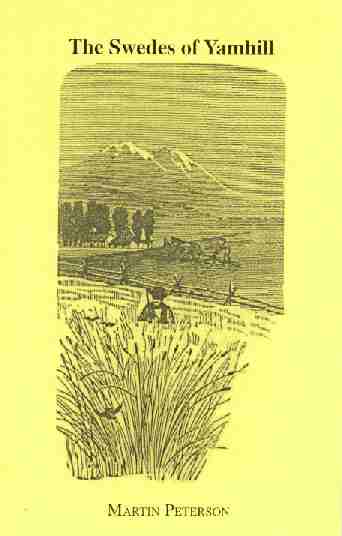
Excerpt from The Swedes of Yamhill
Among the Swedish families who came to Oregon in the last quarter of the 19th century those who settled in the vicinity of Carlton were assisted in getting a foothold by a fellow countryman named John Wennerberg. Born in Hälsingborg, Sweden, in 1837, he lived in that town with his parents until 1852 when he went to sea as a cabin boy on a sailing vessel—not a surprising venture, for Hälsingborg was a busy seaport town on the coast of Skåne. John must have seen and been entranced by the ships and sailors who came and went from the port.
During the next several years John Wennerberg, cabin boy, traveled all over the world. In time he became a minor ship’s officer and as such found himself in Australia during the gold rush of the late 1850s. He left the sea, tried gold mining and apparently made enough money to purchase a sheep ranch there. How long he remained in Australia is not certain, but it was long enough to gain some farming experience and to add to his savings. John Wennerberg had a way with money. He hung on to it.
What manner of man was John Wennerberg? Those who knew him remember him as a quiet, dignified man, who deliber¬ated before offering an opinion or in answering a difficult question. When at length he did speak, he usually began with the phrase, “I fancy that … ,” an English locution that may have dated from his days in Australia. He spoke English with only a faint echo of his native Swedish intonation, that language “tune” characteristic of the Scandinavian tongues. He must have been exposed to English, perhaps learned it at an early age. Ships and sailors hailed from all quarters of the globe, but English ships predominated because of the English need for Swedish iron ore. His letters, too, are literate and well-expressed.
A serious, practical man, be was not much given to humor, but he enjoyed a joke and now and then offered one of his own, twiddling his heavy gold watch chain as he did so. In stature he was average in height, rather heavily built, his bearing reflecting purpose and force.
In the early 1870s Wennerberg set sail for Oregon, partly because of the publicity the Oregon Country was receiving in those years in Australia, but mainly because of his brother, Daniel, who had emigrated from Stockholm to Portland where he estab¬lished himself as an expert cabinet maker. Portland was a small city in the 1870s and it was not surprising than Dan Wennerberg knew a great many of its prominent citizens, among them W. S. Ladd and Simeon G. Reed. Ladd and Reed owned farm proper¬ties in the Yamhill River Valley and it seems likely that Dan recommended his brother, John, to either Ladd or Reed as one who had experience and ability. At any rate, Ladd and Reed em¬ployed John to manage their farm west of Carlton. They had no reason to regret their choice.
Nor did John Wennerberg regret casting his lot with Ladd and Reed. They were exemplary employers, progressive and shrewd in their farming operations. Reed, for instance, laid the foundations for a blooded livestock industry in Oregon and was an early advocate of diversified farming in western Oregon. His Broadmead Farm near Amity, Oregon, was a prime example of diversification with its gardens and orchards and croplands. The farm near Carlton appears to have been somewhat less advanced, but perhaps for this very reason it presented a challenge to Wen¬nerberg, both agriculturally and managerially. It was an excellent training ground for the role he was to play in helping his fellow Swedes gain a foothold in the Carlton area.
John Wennerberg developed a real affection for Carlton and the Yamhill River Valley. Settled by Oregon Trail immigrants in the 1810s, it is an area rich in farmland, woods and streams, with the forested Coast Range to the west and the gently rolling Chehalem Hills to the east. Wennerberg also liked farming, as a business and as an operation—but strictly in that order. He did not shirk farm work, but for him the business side of farming was its real appeal. He had, as they said in those years, a head for business and it was not long before be had a farm of his own, purchased in part with his own money, the rest lent him by his brother, Dan. His first farm was comparatively small but in time be acquired more and more acreage around Carlton, some of it where Carlton now stands.
Over the years Wennerberg brought to his farm a number of Swedes to work as farmhands and housekeepers—Wennerberg never married—and later helped them get started on farms of their own. Thus one might say that he was the founder of the Swedish-American community that grew up around Carlton.
Probably the first of the Swedes to come to Wennerberg’s farm was John Lindberg. The story is told that Lindberg was robbed of every cent he had when he arrived in New York after passing through Ellis Island. A group of cardsharps engaged him in a game of poker and fleeced him of all his savings. It was a devastating experience, but a Swedish girl, a passenger on the same ship that brought John over, helped him recover from the shock not merely by offering sympathy but by lending him enough money to get to his destination—Minnesota. Apparently the friendship ripened into love for in Minnesota in the late 1870s they were married. Subsequently they moved to Oregon where, as mentioned, they worked for Wennerberg, Lindberg as a farmhand and his wife as housekeeper.
